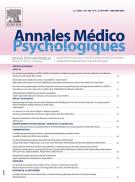Les applications numériques en santé mentale : état des lieux, enjeux et perspectives - 15/04/25
Digital applications in mental health: Status, challenges and perspectives
 , Alexis Bourla a, b, c, d, Pierre-Alexis Geoffroy e, f, g, h, Jean-Arthur Micoulaud-Franchi i, j, David Misdrahi k, l, m, David Petauton n, Ludovic Samalin j, o, Ismaël Conejero p, q, Raymund Schwan k, r, s, t, Olivier Bonnot u, v
, Alexis Bourla a, b, c, d, Pierre-Alexis Geoffroy e, f, g, h, Jean-Arthur Micoulaud-Franchi i, j, David Misdrahi k, l, m, David Petauton n, Ludovic Samalin j, o, Ismaël Conejero p, q, Raymund Schwan k, r, s, t, Olivier Bonnot u, vRésumé |
Les nouvelles technologies, basées sur le numérique, promettent une révolution dans le champ de la médecine. La santé mentale voit émerger de nombreuses innovations telles que le phénotype numérique, la prédiction diagnostique ou les thérapies numériques. Plus particulièrement, les Applications mobiles (Apps) vont contribuer à la psychoéducation, au diagnostic, à l’identification et au suivi des symptômes de façon personnalisée, à la thérapeutique (interventions psychothérapiques, stratégies de coping), à la prévention chez les sujets à risque et enfin à l’aide à la décision médicale. Cependant, de nombreuses revues ou méta-analyses soulignent le manque récurrent de preuves scientifiques pour une grande majorité des outils proposés. Ce point contribue à la défiance observée chez les professionnels en santé mentale vis-à-vis des nouvelles technologies et impose une réflexion sur la définition et l’évaluation de ces outils, mais aussi au niveau de la formation les concernant. Dans cet article, nous rappellerons en premier quels sont les enjeux actuels du numérique en santé mentale et préciserons quelles sont les doctrines des différentes instances impliquées au niveau national dans leur développement. Deuxièmement, nous donnerons une définition de ces différents outils numériques. Troisièmement, après avoir précisé sur quels éléments repose le concept de dispositif médical, qui permet d’offrir des outils scientifiquement éprouvés, nous proposerons des critères actuels et futurs de leur évaluation, en particulier autour de la notion d’acceptabilité. L’objectif global est donc d’apporter aux utilisateurs les repères nécessaires à la constitution d’un cadre théorique pour une utilisation optimale du numérique en psychiatrie.
Le texte complet de cet article est disponible en PDF.Abstract |
Objectives |
New, digital-based technologies promise a revolution in the field of medicine. Mental health is experiencing the emergence of numerous innovations such as digital phenotyping, the use of AI in diagnostics, and digital therapies. Digital technology can improve psychiatry by creating new treatment strategies that are available to a larger number of people. It will enable the development of new therapeutic modalities: mobile applications (Apps) will contribute to psycho-education, diagnosis, identification of and monitoring of symptoms in a personalized way, to therapy (psychotherapeutic interventions, coping strategies), to prevention in at-risk subjects and finally to medical decision support. Finally, digital technology can allow us to exploit new data collection methods and thus improve our scientific research in order to analyze, detect, predict and even prevent symptoms. However, many reviews or meta-analyses stress the recurrent lack of scientific evidence for a large majority of the proposed tools and that there is often a significant gap between the designers’ statements and their real therapeutic potential. In addition, some of these proposed tools are said to be emerging because they present new ideas or improve the service provided. Others are said to be “disruptive”, a term that defines technologies that result in a breakthrough by creating new methods or processes that replace those previously used. Finally, those that need to be developed further are described as “immature”, which is frequently the case in mental health. These different points contribute to the distrust observed among mental health professionals with regard to new technologies. But above all, various studies have shown that rejection was not necessarily due to theoretical positions, but rather to a lack of knowledge and information regarding digital technology. The integration of new technologies in the cultural organization of providing psychiatric care is therefore a real challenge. It is not a question of replacing caregivers, but rather of increasing their efficiency. This imposes a reflection on the definition and evaluation of these tools, but also on the level of training necessary for their use. The evaluation of these tools is in essence multiple, since it involves different actors, each with their own frame of reference. Health professionals refer to an evidence-based methodology, based in most cases on studies that respect standards set by the scientific community and evaluated by peers. Developers refer to processes with design standards, development processes and norms to be respected. Finally, users rely mainly on so-called external resources, which can be expert or non-expert opinions (comments on websites, tutorials from influencers, videos of opinions or comparisons). The evolution and complexity of the technologies used therefore require adapted and above all integrative evaluation models. In this article, we will first review the current challenges of using digital tools in mental health and specify the doctrines of the different authorities involved at the national level in their development. Secondly, we will formulate a definition of these different digital tools. Thirdly, after having specified the elements on which the concept of the digital medical device is based, which will allow us to propose scientifically proven tools, we will offer current and future criteria for their evaluation, based in particular on the notion of acceptability. The overall objective is therefore to provide users with the necessary reference points for the constitution of a theoretical framework for the optimal use of digital technology in psychiatry.
Le texte complet de cet article est disponible en PDF.Mots clés : Acceptabilité, Application mobile, Dispositif médical, Santé mentale numérique, Thérapie numérique
Keywords : Acceptability, Digital mental health, Digital therapy, Medical device, Mobile application
Plan
Vol 183 - N° 4
P. 413-420 - avril 2025 Retour au numéroBienvenue sur EM-consulte, la référence des professionnels de santé.
L’accès au texte intégral de cet article nécessite un abonnement.
Déjà abonné à cette revue ?

